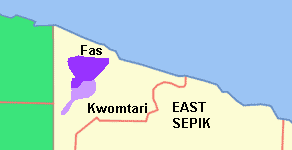Kwomtari languages
| Kwomtari | |
|---|---|
| Geographic distribution: | Papua New Guinea |
| Linguistic classification: | perhaps Left May – Kwomtari or Kwomtari–Fas |
| Subdivisions: |
|
| Glottolog: |
kwom1263 (Kwomtari–Nai)[1] guri1248 (Guriaso)[2] |
|
The neighboring Kwomtari and Fas language families | |
The Kwomtari languages are a small language family of Papua New Guinea.
Classification
The family consists of at least the two relatively closely related languages Kwomtari and Nai. Baron adds the highly divergent language Guriaso:
but Glottolog does not accept that the relationship has been established.[2]
There has been confusion over the membership of the Kwomtari family, apparently due to a misalignment in the publication (Loving & Bass 1964) of the data used for the initial classification. (See Baron 1983.) The Kwomtari languages are generally classified as part of a larger as yet unproven Kwomtari–Fas family, which confusingly is also often called "Kwomtari" in the literature. However, Baron sees no evidence that the similarities are due to relationship. See Kwomtari–Fas languages for details.
Guriaso shares a small number of cognates with Kwomtari–Nai. Baron (1983) says the evidence is convincing once a correspondence between /ɾ~l/ and /n/ (from *ɾ) is established:
| Gloss | Guriaso | Kwomtari |
|---|---|---|
| Verb suffixes (1pl, 2pl, 3pl) |
-nɔ, -mɛ, -no | -ɾe, -mo, -ɾe* |
| dog | map | mau |
| ear | mətɛnu | futɛne |
| crocodile | mɔməni | maməle |
| small | tɔkəno | tɔkweɾo |
| nose | apədu | tipu** |
* Compare Biaka -ɾo, -mo, -na.
** Metathesis of /p/ and /t/.
However, the conclusion that Guriaso is related to Kwomtari is disputed by Glottolog.[2]
References
- ↑ Hammarström, Harald; Forkel, Robert; Haspelmath, Martin; Bank, Sebastian, eds. (2016). "Kwomtari–Nai". Glottolog 2.7. Jena: Max Planck Institute for the Science of Human History.
- 1 2 3 Hammarström, Harald; Forkel, Robert; Haspelmath, Martin; Bank, Sebastian, eds. (2016). "Guriaso". Glottolog 2.7. Jena: Max Planck Institute for the Science of Human History.
- Baron, Wietze (1983). "Kwomtari survey" (PDF).
- Laycock, Donald C. (1975). "Sko, Kwomtari, and Left May (Arai) phyla". In Stephen A. Wurm. Papuan languages and the New Guinea linguistic scene: New Guinea area languages and language study 1. Canberra: Dept. of Linguistics, Research School of Pacific Studies, Australian National University. pp. 849–858. OCLC 37096514.
- Loving, Richard; Jack Bass (1964). Languages of the Amanab sub-district. Port Moresby: Department of Information and Extension Services. OCLC 17101737.
External links
- Wietze Baron, The Kwomtari Phylum (accessed 2011-4-15)
